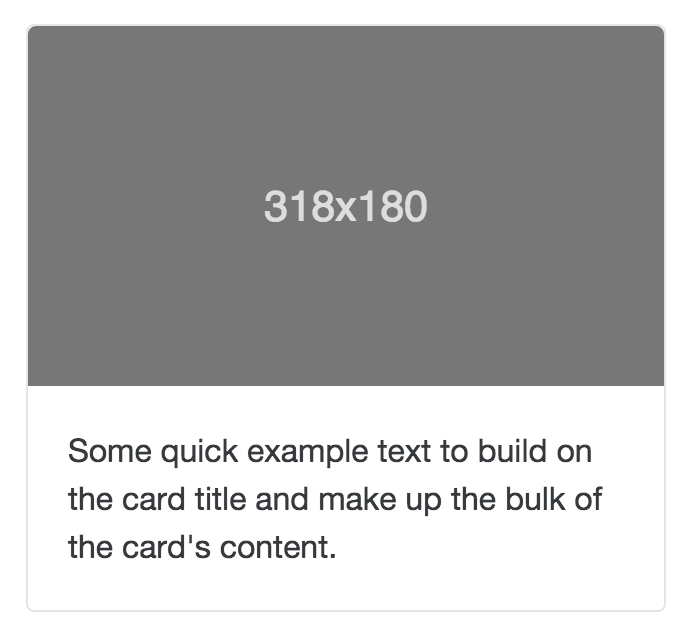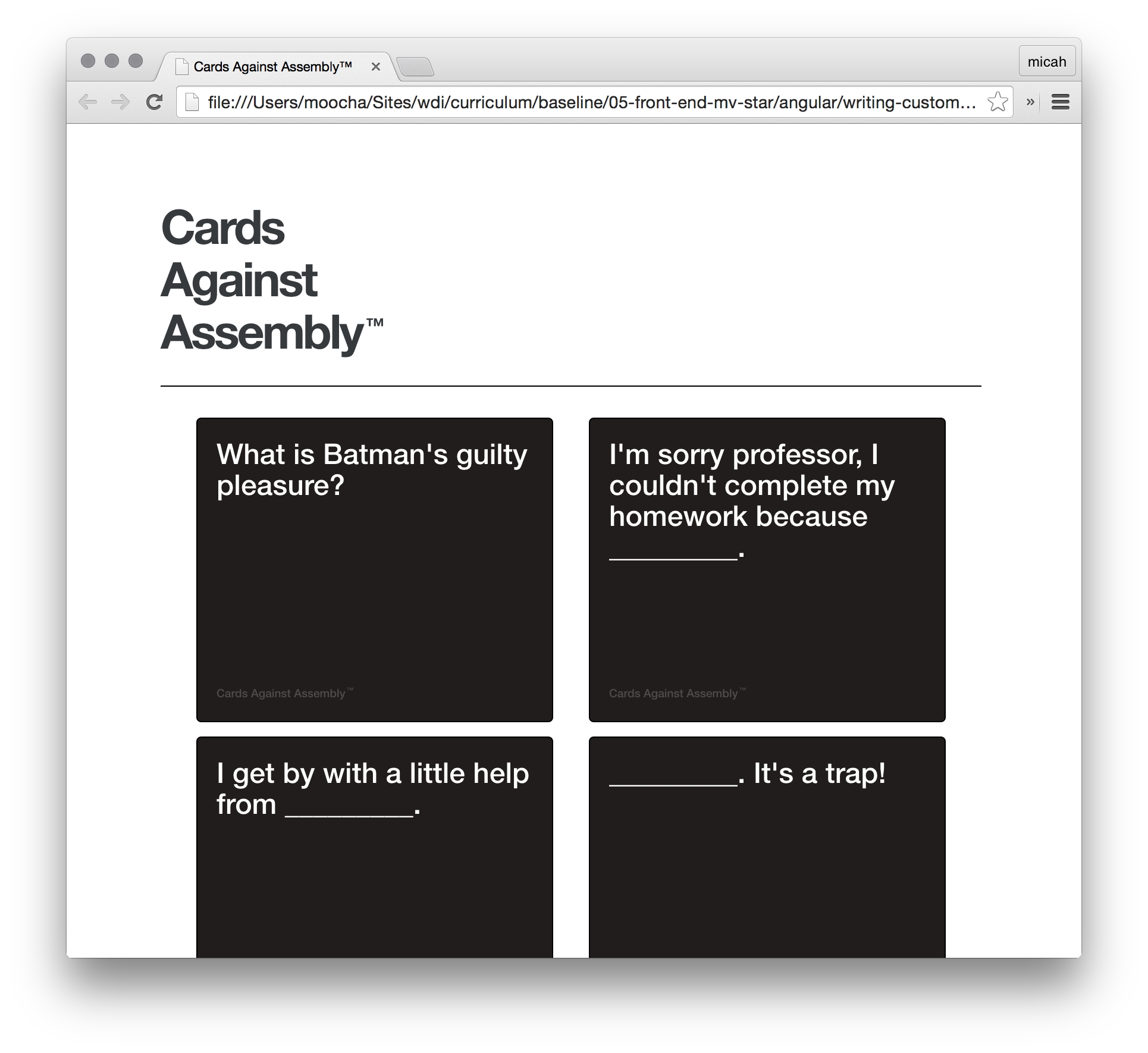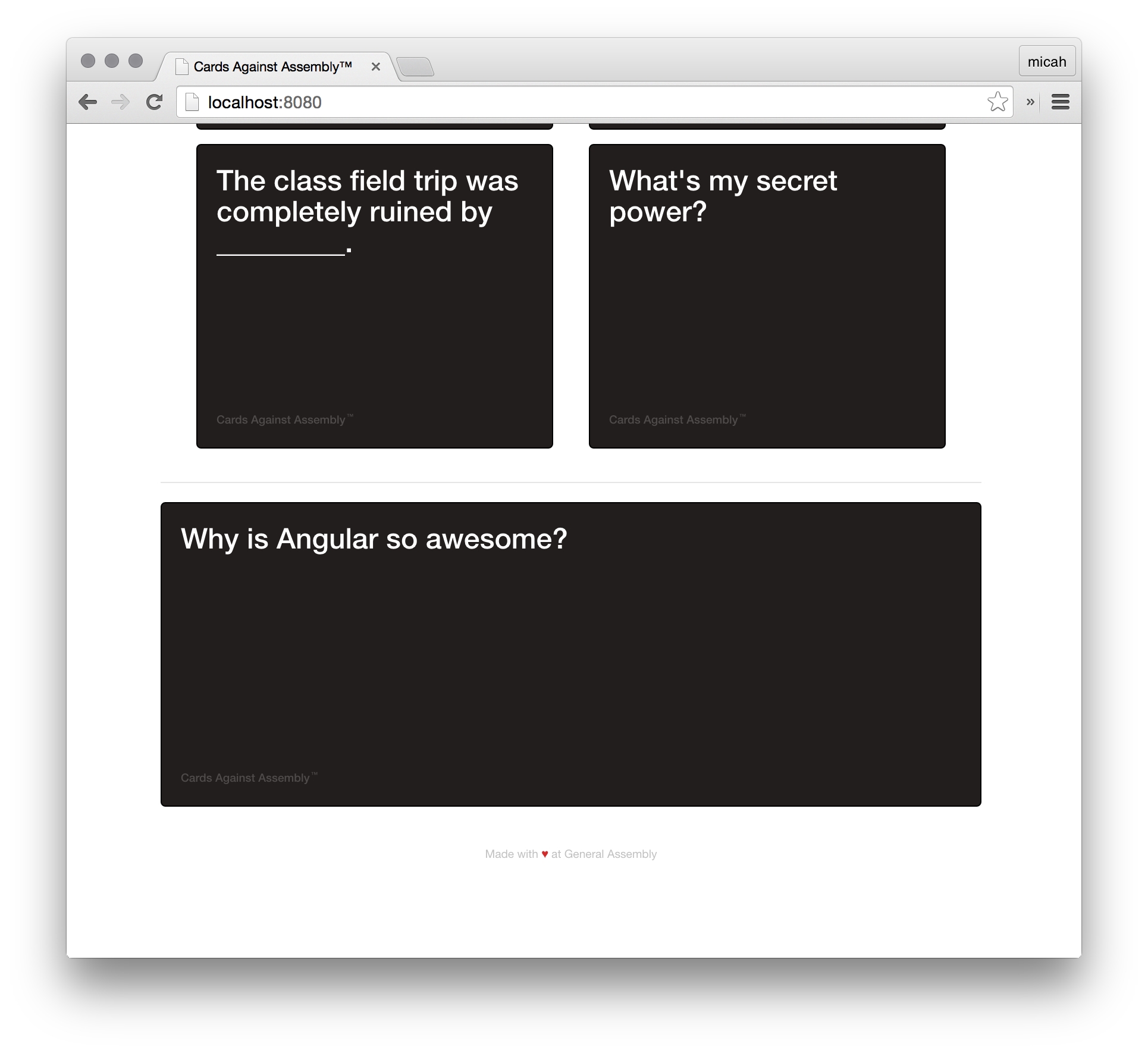Angular Custom Directives
Warning: This content is considered archived as .directive is no longer used - this changed between versions Angular 1.4 and 1.5. There is a somewhat updated version of the lab described here that can be found on GitHub. Both this project and this page are on our list to be refactored for Angular 1.5+.
Objectives
Describe the different types of custom directives available
Create a custom directive
Explain why custom directives are valuable
Modularity with Custom Directives
As you've seen by now, a huge amount of the code you work with in Angular are directives. Angular was designed to be an extension of HTML - a way to have custom-defined interactive tags of your own making.
While we've been getting good at using the directives that come with Angular, it's time to start seeing what we can do if we start making own own.
One of the most obvious uses of this is when you've got repetitive code to render some information or data. If you're using a bunch of tags all over the place, it's a DRY principle – you might forget a tag or decide to change something and have to change it in a million places.
By extracting it to a custom directive, we can reference that directive whenever we need to use it and not worry about repeating the code to render it.
Real World Example
As an example, we're going to mess around with duplicating something that's becoming a common pattern in interface design – the concept of a card. Applications like Twitter, Pinterest, Facebook, and a lot more are moving towards this design pattern.

Everyone's favorite CSS framework, Bootstrap, is even on board, where in version 4+ you're able to create a card with just some CSS classes:

Let's see if we can make something similar, wrapped up in our own custom HTML element.
Cards Against Assembly
Starter Code
https://github.com/WDI-SEA/cards-against-assembly
Take five minutes and inspect our starter code. You'll see a pretty normal Angular app, and since we're repeating using those cards, and there's a few consistent tags we're repeating every time we render a card, we're going to experiment with making those cards a custom-defined directive.

Building a Simple Directive
Using our starter code, our goal is to take:
and end up with a reusable <card></card> component, maybe something like:
Let's be organized!
Rather than just throw this wherever, let's make a file dedicated to this directive.
Directives are as easy as...
Just like controllers, factories, anything else we've made in angular, we're going to use a function to add another component. In this case, we'll make a cardView module and add a directive to it. That directive will have a function that returns everything related to the directive.
An important thing to point out: The first argument of directive is the name of the directive and how you'll use it in your HTML; and remember, Angular converts camelCase to snake-case for us, so if you want to use <secret-garden></secret-garden> in your HTML, name your directive .directive('secretGarden', ...). Remember, in the official Angular docs it's called ngClass or ngRepeat, but in your HTML you use ng-class and ng-repeat.
Directive Options
There's a few interesting options when making your own directives. We'll go through them all, quickly, and you can play with them on your own in a bit.
restrictreplacetemplate/templateUrlscope
1. restrict
restrictWhile the name isn't obvious, the restrict option lets us decide what kind of directive we want to make. It looks like this:
Eis element. An HTML element, like<card></card>Ais attribute. Like<div card="something"></div>Cis class. Like<div class="card"></div>
You can choose to have just one, all of the above, or any combination you like. You should steer towards elements & attributes as much as possible, though – classes can get messy with other CSS classes.
For ours, let's play with just an element.
2. replace
replaceReplace is pretty straightforward. Should this directive replace the HTML? Do you want it to get rid of what's in the template & swap it out with the template we're going to make? Or add to it, and not remove the original. For example, replacing would mean:
Would actually render as:
See, replaced. Let's say we like that for our example:
3. template/templateUrl
template/templateUrlThis is where our partial view comes in. Now, if it's a pretty tiny, self-contained directive, you can use template: "Some javascript " + string + " concatenation";
But that easily starts getting ugly, so it's often better (even for small directives like this) to make a quick little partial HTML file and reference it with templateUrl instead.
Let's extract our existing card tags, and throw them in a partial. Cut out:
Quickly touch cardView.html or some similarly obvious-named partial, and paste it back in.
In cards/cardView.html:
In js/cardView.js, we can add our option:
And lastly, in our index.html, let's finally use our custom directive.
Before testing out the directive, make sure that index.html has the script tag for the directive, and the directive module is injected into the app. Also, remember to run this using a HTTP server
In app.js:
TRY IT! So awesome! We've now got this much more readable index.html, with a very semantic HTML tag describing exactly what we want rendered.

This is awesome. This is a great, reusable component. Except for one thing.
4. scope
scopeIf you notice, our template uses {{card.question}} inside it. But what if we wanted to render a card somewhere outside of that ng-repeat, where card in cards isn't a thing. What if we want to render a one-off card, reusing our new directive elsewhere?
Just like controllers, we want to define what our scope is. We want to be able to say "Render a card, with these details, in whatever context I need to render it in." A card shouldn't rely on a controller's data to know what information to render inside it. The controller should pass that data to our directive, so it's freestanding and not relying on anyone but itself.
That's where scope comes in, and this lets us decide what attributes our element should have! For example, in our card example, maybe we want to render a card with just a string somewhere outside of this controller. We want to make our own card with our own hardcoded text.
Try this. In your index.html, adjust our <card> element to say:
In context, you'll see that the ng-repeat is giving us the variable card, and we're actually just rendering that out as a string. But we've decided we want to have an attribute called question to pass data through. We made that up, it's appropriate to our example, but it can be anything.
There are only two other pieces we need to make this reality.
In our cardView.html partial, let's adjust to:
No longer reliant on a variable named card, it's now just reliant on an element having the attribute of question.
And finally, in js/cardView.js:
In scope, we just define an object. The key is whatever want the attribute on the element to be named. So if we want <card bagel=""></card>, then we'd need a key named bagel in our scope object.
The Different Types of Scope for a Directive
The value is one of 3 options.
The corresponding options would look like:
The = is a mechanism for binding data that might change; the & is for passing a reference to a function you might want to call; and the @ is simply storing a string & passing it through to the template.
Since we've decided to use @/strings, let's try it!
@/strings, let's try it!Our last test is to see if we can make a card using just a hardcoded string. Then we'll know our card is really reusable.
Somewhere outside the context of the controller, let's say just above the footer in our index.html, throw a handmade card in:

Would you look at that? Our own custom directive - a reusable, semantic HTML component that we designed ourselves.
Before we continue... additional topics
Your assignment will involve making directives with more functionality than just a card. In order to provide additional functionality, the controller property is incredibly useful for creating a separate controller for the entire directive.
Example:
Now if we update cardView.html, we can add this function to the template. Let's do so via the ng-click directive.
Conclusion
Where can you imagine using custom directives?
What four types of directives can you make?
How do you pass information into a custom directive?
Last updated
Was this helpful?